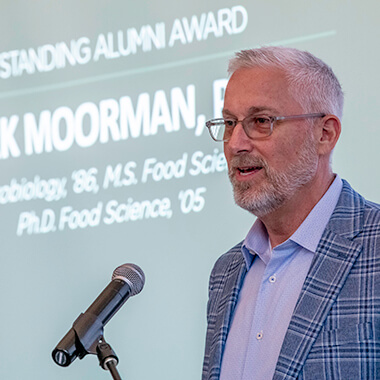MGI Professor Deciphers Evolution's Hidden Information in New Book
Chris Adami’s newest book, The Evolution of Biological Information, flew to the top of the Amazon Best Sellers list in information theory when it published earlier this year and remains there today.
“There’s a famous saying in biology which says, ‘Nothing in biology makes sense except in light of evolution,’ and I have co-opted that statement and said that it is in light of the information,” says Adami, a professor in MSU’s Department of Microbiology, genetics, & Immunology.
Through the lens of information theory, biology can be quantified in unique ways that reveal hidden insights. With his book, published by the Princeton University Press, Adami illustrates how information theory can be applied to help explain how cells can communicate or how infections can evade treatments.
“Everybody agrees. Evolution is so important, but what is evolution? Evolution is a process that basically pulls the information from the world and writes it into the genome,” Adami said. “It’s not the organism that evolves, it’s the information that evolves.”
That is, DNA encodes not just information about an organism, but the organism’s environment as well.
"In our genome is information about the world, how to function in this world, how to be successful in the world,” Adami said.
“It's often said that we live in the information age,” said Richard Lenski, a Hannah Distinguished Professor at MSU and leader of the famed Long-Term Evolution Experiment.
“In this thought-provoking and wide-ranging book, Adami makes the compelling case that we and our ancestors — back to the primordial life that emerged billions of years ago — have always lived in an information age,” Lenski said. “And while DNA sustains life’s information on Earth, it is the propagation of information, and not the double helix, that will define life elsewhere in the universe.”
Adami and Lenski are longtime collaborators who have authored several high-profile papers together, asking similar questions about evolution, but approaching them in very different ways.
Lenski’s long-term experiment has been tracking the evolution of 12 E. coli cultures since 1988, long enough to observe more than 75,000 generations. Adami is a computational biologist whose research plays out in computer simulations rather than petri dishes.

“In my lab, we try to understand how the evolutionary process generates complex things from simple things,” Adami said “We use different tools for that – theory being one of the main tools, because I’m a theorist in my training. Computation is another. We set up something in the computer, let the process go, and then check what it looks like. Does that look like what the theory would have predicted?”
This work helped frame Adami’s pioneering perspectives on Darwinian evolution and information theory, which, in turn, fueled even more publications from Adami’s lab. His book now provides a comprehensive, in-depth account of that perspective and how it can help predict the outcomes and complexity of biological processes.
“Darwinian theory remains the same,” says Adami, “I just have a different way of explaining it."
Adami also authored the textbook, Introduction to Artificial Life, published in 1997. To learn more about The Evolution of Biological Information, visit the Princeton University Press site.


